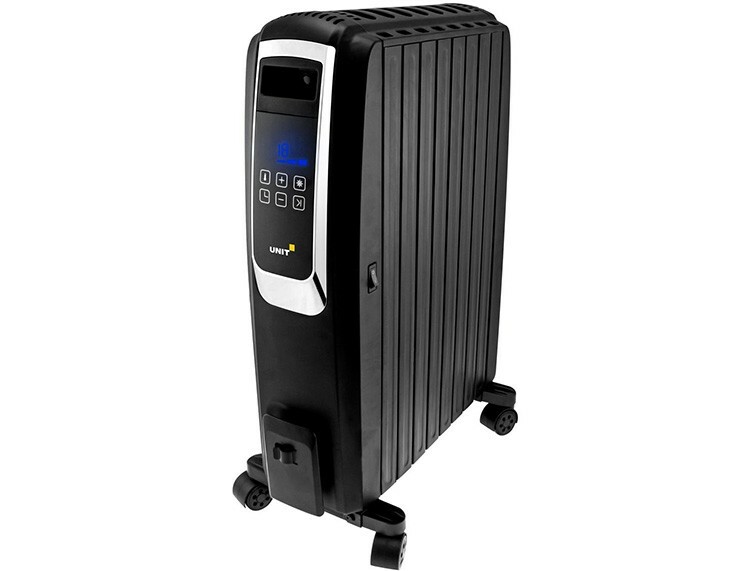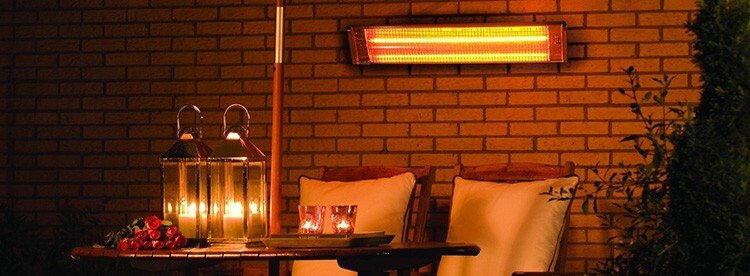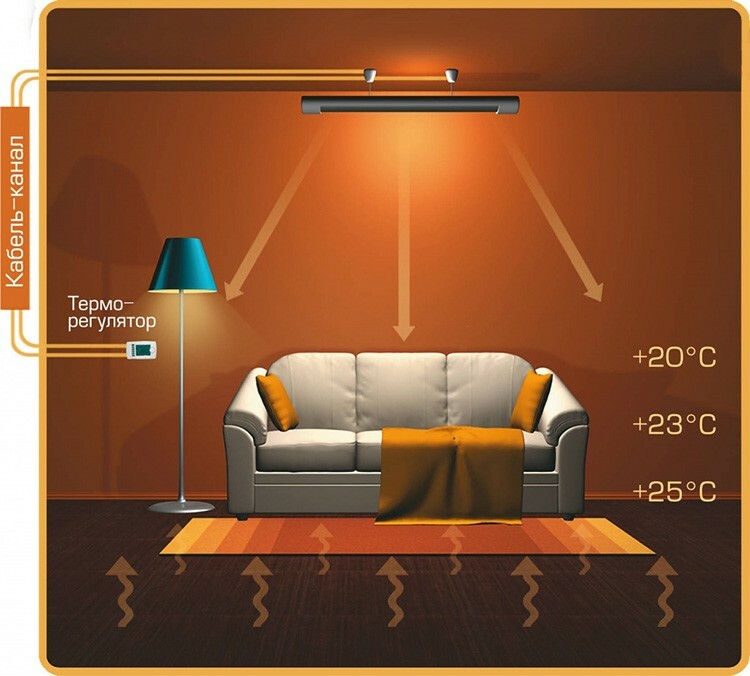
CONTENT
- 1 Existing types of electric air heaters: advantages and disadvantages
- 2 Division of electric heaters for summer cottages and houses by installation method
- 3 Calculation of the power of heating equipment
- 4 Energy-saving electric heaters for the home: the price of different types
Existing types of electric air heaters: advantages and disadvantages
In order to choose the optimal device for creating a comfortable temperature, you need to navigate the variety of electric heating devices on the market.
First of all, it should be decided that the purpose of the heater, regardless of its type, is to create an additional source of heat in the apartment at times when the central system fails and the microclimate of the room becomes uncomfortable.

FOR YOUR INFORMATION!
Electric heaters for summer cottages are most often used in autumn or spring, since there may be no other source of heat in the cottage.

In total, there are four main types of devices for heating a room:
- oil radiators;
- convectors powered by the electrical network;
- thermal fans;
- emitters where infrared radiation serves as a heat source.
Oil-fired electric home heaters
The most common type of appliance, which is familiar to everyone who has purchased a heater at least once. The device is a sealed housing with technical oil inside. A heating element is used for heating, immersed in an oily liquid.

FOR YOUR INFORMATION!
Depending on the size and model, several heating elements can be used, which allows for faster heating, but requires more energy.

The use of oil radiators can be considered an ideal option both for an ordinary apartment and for your own home. When choosing a specific model, it is very important to select the right device in terms of power in order to achieve efficiency in use.

The positive aspects of oil-fired electric heaters for home heating are:
- a thermostat built into the device, which is used to set the optimal temperature. In the presence of two thermal elements, there will also be two adjustment knobs;
- mobility. Most often, these devices in their dimensions do not exceed the dimensions of a conventional central heating radiator, which allows them to be placed in the desired room. Also, for ease of movement, most modern models are equipped with wheels;
- acceptable cost. The simplicity of the design provides a low cost compared to more complex varieties;
- ability to accumulate heat. The oil cools slowly, which makes it possible to obtain a residual temperature even after disconnecting the device from the mains. This feature allows you to save on electricity.
FOR YOUR INFORMATION!
Some models of room electric oil-type heaters are equipped with fan heaters, which reduces the time for complete heating of the room.


The disadvantages of oil coolers are:
- a long heating process, which is compensated by a long time for complete cooling;
- strong heating of the case, which is most often metallic. Without a special protective casing, there is a high probability of getting burned when touched;
- a lot of weight, so models that do not have wheels lose mobility.
Electric convectors
The next type of heaters in their work uses the principle of convection. This means that the device in the lower part sucks in cold air, which passes through the heating element, heats up and exits through the upper ventilation holes, rising to the ceiling.

Further, heat is returned to the walls, ceiling, which leads to cooling of the air and its lowering to the floor. Then the cycle is repeated.
The obvious advantages of such models are the following factors:
- lack of noise during operation;
- low heating of the case. Most often, the temperature does not rise more than 65 ° C, which makes them safe;
- the presence of a built-in thermostat, which provides not only the ability to adjust the thermal regime, but also automatically turn on or off the device;
- overheating protection, which activates an emergency shutdown when the permissible parameters are exceeded.

These models of electric heaters, according to reviews, have a number of disadvantages:
- the complexity of self-assembly, when it comes to wall or embedded models;
- low heat transfer, which does not allow high-quality heating of large areas;
- high price.
Economical infrared electric heaters of a new generation
A heating element of this type are special lamps that have the ability to emit long wavelengths in the infrared range, invisible to the human eye. By the type of lamps, this type of heater is divided into:
- Halogen, in which a glass bulb with a thread is installed, filled with one of the inert gases.

Infrared models are suitable for heating balconies or terraces in a private house - Carbonwhere the finest carbon fiber filaments act as a heating source.
- Quartzthat provide the necessary heat thanks to the presence of tungsten wire.
The principle of operation of infrared heaters is similar to solar heat. Through the distribution of long waves, the surrounding objects (floor, walls, furniture) are heated, which subsequently give off heat to the air.
The advantages of infrared models are:
- complete absence of noise during operation;
- economical consumption of electrical energy;
- lack of fans, which provides the necessary heating without dust and dirt;
- uniform heating of the air;
- gradual heating;
- during operation, this type of device does not lead to the combustion of useful oxygen and does not dry the air.

The only significant drawback, according to users, is the overpriced cost of these devices.
Electrical panels for home heating
One of the innovations in the field of heating technology is electric heating panels. These are devices that combine the positive aspects of two separate devices at once.
One method that is applied in use is the principle of convection, whereby cold air passes through a heating element located inside and heats up. As a supplement to improve efficiency, infrared sources are used in the heating panels.

FOR YOUR INFORMATION!
It is very important to use a ceramic panel as the main part of the heater. Providing high heat dissipation, ceramic is considered the most efficient material, helping to further reduce electrical energy consumption.


The advantages of electric wall-mounted or floor-standing ceramic heaters are:
- lack of noise, since there are no mechanical elements in the structure;
- safety provided by the absence of heating of external surfaces and an emergency shutdown system;
- high efficiency, since ceramics give off heat for a long time;
- durability. The average service life of the panels is 30 years;
- attractive appearance, which allows using this type of heating devices as a full-fledged element of the interior.
Among the shortcomings, one can note the complexity of repairs in the event of a unit failure, the high price of equipment and the presence of noise in models additionally equipped with fans for forced distribution of the heated air.
Electric floor fan heaters
Models that are among the most affordable due to their low cost. Ease of use is also one of their advantages.
The principle of operation of these devices is elementary - there is a heating element inside the case through which air is blown, which leads to its rapid heating. A prerequisite is the presence of a fan that ensures the movement of warm air for the prompt filling of the room.

There are three types of heating elements that are used in fan heaters:
- an open spiral that can heat up to 800 degrees;
- an element in the form of a tube, which can give indicators up to 200 ° C;
- ceramic tiles, also capable of heating up to 200 ° C.
FOR YOUR INFORMATION!
The use of a ceramic heating element provides cleaner air at the outlet, which is free of combustion products.

The advantages of such models are:
- providing fast heating of any room;
- compactness;
- the ability to carry out both heating and cooling;
- low price.

The main disadvantage that can be identified is the ingress of combustion products into the air in the presence of open heating elements, as well as excessive drying of the air.
Economical electric heaters of inverter type
Another market novelty that quickly gained recognition from ordinary consumers was electric inverter heaters. These are devices that combine high efficiency and economy.
By the principle of operation, these devices resemble a conventional air conditioner. The main part is the heat pump, inside which the heat exchanger is located. The filling of the inverter heater is freon. It enters the heat pump, heats up to a temperature of 80 ° C and then passes into an external chamber with low pressure. As a result, it becomes gaseous, which leads to the release of a large amount of heat.

The advantages of the inverter are:
- economical, since the device operates in automatic mode and never turns off completely. This allows you to save up to 50% of electricity in comparison with conventional appliances;
- safety and environmental friendliness;
- almost complete absence of noise;
- high performance.
The disadvantages of using such heaters are:
- high price;
- the need for voltage stabilization;
- the complexity of the repair due to the lack of standardization of spare parts.

Division of electric heaters for summer cottages and houses by installation method
When choosing a heating device, it is also necessary to provide for the place of its installation, since this will allow the most efficient placement of the heater. Also, some types of electrical appliances require compliance with safety regulations during installation so as not to cause a fire. Floor standing electric heaters
As the name suggests, this type is placed on the floor. As a rule, such models are distinguished by their increased dimensions in order to ensure rapid heating of any room in terms of area. Floor-standing versions can have such types as oil radiators, convection devices, infrared. The main advantage of floor models is the absence of the need for installation. They can be moved to the desired room, the most important thing is that there is an electrical outlet in the immediate vicinity.

Economical wall mounted electric heaters
The next place where you can place heating devices is the wall. In this case, the device is permanently installed, which does not allow moving it around the apartment or house. Wall-mounted versions can have such types as convection, infrared heaters and devices in the form of panels.
The advantages of using the wall-mounted version is their safety, since the rigid mount prevents the device from falling.

FOR YOUR INFORMATION!
The use of a wall-mounted electric household heater, made in the form of a panel or a picture, will become not only a way to warm the air, but also decorate the interior.

Another feature of modern wall-mounted heating appliances is the possibility of remote control. Since in order to get to the controls of a wall-mounted electric heater with a thermostat, it can be problematic, manufacturers provide for the possibility of setting the desired temperature or on / off unit from the remote control.
Calculation of the power of heating equipment
An important criterion when choosing a heater for a home is the calculation of the minimum power that the device must have in order to ensure complete heating of the required area.
The simplest formula can be considered the statement that it will take 100 kW to heat one m² of the room. Thus, in order to warm up a room of 20 m², the required power of the heater must be at least 2000 kW. Otherwise, there is a high probability of excessive or insufficient heating.

In fact, everything is much more complicated. To accurately determine this indicator, it is required to take into account a large number of parameters:
- the required comfortable room temperature;
- air density (constant);
- heat capacity of the air;
- possible heat loss;
- accounting for thermal insulation.
The result is a rather complex formula. Therefore, for simplicity of calculations, the editorial staff of the portal advises using special calculators on the Internet, where the user is simply required to enter the necessary parameters to obtain the optimal heating power systems.
Energy-saving electric heaters for the home: the price of different types
Depending on the type of heater chosen for purchase, it is necessary to take into account the cost of each model. The cheapest are heat fans, the price of which starts from 959 rubles for simple models (Electrolux EFH / S-1115).
Electrolux EFH / S-1115

Electrolux EFH / S-1115
Royal Clima ROR-C7-1500M Catania

The next category in ascending order of price is oil radiators, which can be purchased within 3-4 thousand rubles. The final cost is determined by the number of sections, the number of heating elements, the presence of an electronic control system. One of the best options, according to buyers, among oil heaters is Royal Clima ROR-C7-1500M Catania, which is sold at a price of 2,260 rubles.
Royal Clima ROR-C7-1500M Catania
Scoole SC HT HM1 1000W

Electric convectors can also be considered inexpensive. There are models on the market that cost less than 2,000 rubles. Scoole SC HT HM1 1000W, which sells at a price of 1,290 rubles, can be considered a striking representative of inexpensive models.
Convector Scoole SC HT
AEG IWQ 120

Infrared models are distinguished by a wider range of prices. There are models on the market that cost 2,700 rubles (AEG IWQ 120), and you can find devices that have a price tag of 9,000 rubles. Also when deciding to get an inexpensive infrared heater you can be advised to take a closer look at portable models, the cost of which is only 900 rubles while maintaining the efficiency and positive qualities of this type of devices.
Infrared heater AEG
The most expensive are large-area ceramic panels, which are made in the form of a panel or a picture. The price tag for such devices, which are a full-fledged part of the interior of a bedroom or even a bathroom, starts at 9,000 rubles. The most popular are models from the KAM-IN series. For example, KAM-IN Picasso Black, intended for a bathroom, can be bought for 6,800 rubles.
The choice of a heater for a house or a summer cottage is a necessity in the autumn-spring period, when it is cold outside, but heat has not yet been given to the apartment or has already been turned off. Once again, the video presented will help to determine the specific type and features of electric heaters.
Read also:
How to choose an electric wall heater


